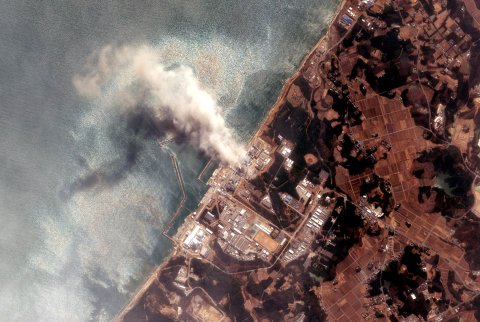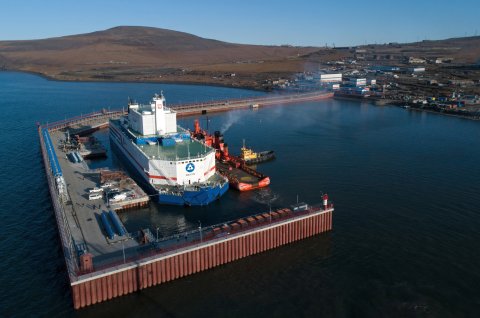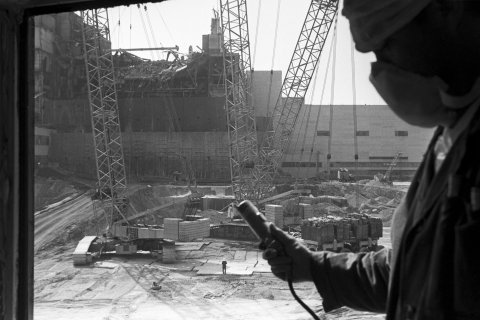
The U.S. and 80 other countries agreed in November at the COP26 climate conference in Glasgow, Scotland, to convert most of the world to green energy in a few decades. It's a necessary step to curb greenhouse gases that cause climate change, but it comes with a daunting challenge: how to simultaneously meet a worldwide demand for energy that is expected to rise as fast as the temperatures.
A new generation of nuclear reactors is emerging as a potential solution. These are not the troubled giant reactors of old, with their big cooling towers and mazes of cooling pipes that guard against the possibility of a China-syndrome meltdown. The new reactors are designed to be simpler, safer, cheaper and much, much smaller.
One tiny reactor the size of a school bus could supply power to a nearby town or factory. Or many of them could be strung together to equal the output of a giant nuclear plant. Not only are they expected to be safer and to produce electricity more cheaply than conventional nuclear plants, they also do so without releasing so much as a puff of greenhouse gas.
In the switch to renewable energy, tiny nukes could play an enabling role. Solar and wind power alone may not be enough to meet the soaring demand for energy in the coming decades. In 2019 and 2020, nations around the world added 270 gigawatts of solar and wind power to their grids, but these renewable sources still need to be supplemented at times of peak demand or when the sun isn't shining and the wind isn't blowing. At present, natural gas, a fossil fuel, usually fills that role. COP26, however, takes that option off the table.
Several new high-tech tiny reactors are now under commercial development at more than a dozen companies. The first round of mini-reactors is slated to be deployed in the U.S. and elsewhere within the next three years. The $1.2 trillion bipartisan infrastructure and jobs bill championed by President Joe Biden and signed into law in November includes $2.5 billion earmarked for advanced nuclear-power development, some of which will go to mini-nukes. "A totally different wave of innovation in nuclear power is coming up," says Jacob DeWitte, founder and CEO of Oklo, a mini-reactor startup that hopes to do to the nuclear power industry what Tesla has done for electric cars.

"I don't see any downsides to them," says Jason Herbert, a senior director at Energy Northwest, a public utility in Seattle and the surrounding area that is considering adding several mini reactors to its network of solar, wind and hydro-power plants. "We're on the precipice of a nuclear revolution."
To be sure, the new nukes have not yet proven their mettle in the commercial world. Many longtime nuclear-power critics remain skeptical that the new technology will overcome the industry's history of safety problems and cost overruns. "This isn't about saving the climate, it's about saving the industry by repackaging old concepts," says Shaun Burnie, senior nuclear specialist for Greenpeace East Asia.
With climate change looking more and more like a planetwide ticking time bomb, the economics of energy may be shifting in the favor of nuclear power. Tiny nukes, in particular, may be poised to take advantage of this shift.
Green-Energy Economics
Nuclear power used to have a strong future. Then in 1979, the Three Mile Island nuclear plant in Pennsylvania underwent a partial core meltdown, which led to a mass cancellation of new plant orders in the U.S. Hopes of a rebound were dashed in 1986 when the Chernobyl nuclear plant in the Ukraine suffered a full meltdown and reactor breach.
The industry again slowly rebuilt its credibility. By 2010, 104 nuclear plants were running smoothly in the U.S., with plans for dozens more in the works, leading to talk of a "nuclear renaissance." A year later, a tsunami hit Japan's Fukushima nuclear plant, causing a meltdown and the evacuation of more than 150,000 residents.

Still, it wasn't the continuing concerns over safety, nor the lack of a good solution for storing nuclear waste—a problem with no apparent solution—that most hurt the industry after Fukushima. Rather, it was economics. The price of natural gas plunged, followed by renewable energy. Meanwhile, nuclear power slowly got more expensive, due largely to plant-construction cost overruns that ran well into the billions of dollars.
As a result, nuclear power has lately been growing at about a thousandth the rate of solar and wind power. Japan, which once embraced nuclear, has shut down the great majority of its plants, as has once proudly pro-nuclear Germany, where the resolutely anti-nuclear Green Party scored big gains in recent elections. Today, nuclear plants generate about a tenth of the world's electricity, down from a fifth in the 1990s.
The drive to green energy, combined with the prospect of having to do without the natural-gas plants that have been essential to keeping the grids going when solar and wind fall short, has dramatically altered the outlook for nuclear power. In fact, nuclear plants already generate more than half of the U.S.' carbon-free electricity. "As natural gas starts to disappear from the grid, nuclear becomes more and more competitive," says Jess Gehin, associate laboratory director for nuclear science and technology at the Idaho National Laboratory.
What's more, prices for nuclear power have been slowly declining in recent years, thanks to plant improvements that have increased efficiency by nearly 30 percent compared to 15 years ago. New designs for large plants are expected to lower the costs further, as well as improve safety and reliability. Indeed, pushing for new nuclear power capabilities is one of the few things Republicans and Democrats tend to agree on.
Full-size nuclear plants still have one big drawback: their size, complexity and infrastructure demands continue to make construction projects daunting, hard-to-finance, budget- and timeline-busting affairs. The combined cost of the two new reactors under construction at a Georgia nuclear plant—the only large commercial reactors currently being built in the U.S.—has doubled to $28 billion since the original estimate when construction was approved in 2012. The plant is now five years behind schedule.
"There's an appetite to build something different from what we already have," says Allison Macfarlane, a former chair of the U.S. Nuclear Regulatory Commission (NRC), and now a professor and director of the School of Public Policy and Global Affairs at the University of British Columbia.
That's why attention is turning to the new mini reactors—though, in a sense, they're not really all that new. Micro-reactors have been around since the 1950s, mainly for specialty applications such as test reactors in labs, power-plants for submarines and a variety of other military uses. Commercializing them never made much sense because they were, in fact, more expensive to manufacture, per kilowatt-hour, than the big conventional plants. They also didn't come close to meeting the much-more-stringent safety standards of civilian operation, in part because they often relied on less-stable forms of uranium and other riskier fuels.
The new mini-reactors overcome those drawbacks. Although they use the same basic physics as conventional reactors—decaying uranium heats water, producing steam that turns electricity-producing turbines—they have simpler designs with fewer points of failure. For instance, rather than relying on a maze of pipes and pumps to direct water and steam where they're needed, they typically depend on natural convection: As the water heats, it rises up away from the uranium fuel rods and transfers its heat to a water-filled coil that shoots steam into the turbines. The cooled reactor water then sinks back down to the fuel rods, keeping them cool.
In contrast to conventional reactors that needed elaborate cooling systems to keep them from overheating and melting down, tiny nukes are designed to be self-stabilizing. If uranium fuel starts to get too hot, some of the water in the reactor turns into steam, which carries heat away from the reactor and ultimately returns as water to keep things cool.

The new tiny nukes also offer what might be called economies of small scale. They can be built in factories at low cost and then shipped via truck to their ultimate destination. For added safety, they can be sealed and buried. At retirement, there's no need for a half-billion-dollar, multi-year "decommissioning" process, as large reactors require. A tiny nuke can be loaded onto a truck bound for a storage facility and a new one swapped in.
The small scale of the new nukes could overcome many of the financial drawbacks of conventional nuclear power. Since the mini-reactors can be operated in tandem, a plant operator could install several pre-fabbed reactors, one at a time, spreading out costs and simplifying projects to stay on time and within budget. The end result, though, could be a group of reactors that together put out as much power as a conventional large one. Individual reactors in such a group could be switched on and off depending on the level of power needed in the grid at any one time. This feature would come in handy when trying to balance the varying output of wind and solar generators or matching the ebb and flow of consumer and business electricity consumption.
"Small reactors can go from full power to 40-percent power in as little as 12 minutes, compared to at least several hours for large reactors," says Herbert of Energy Northwest. "With electric power being traded on the grid minute by minute, the ability to quickly ramp up and down becomes very powerful."
Nuclear Startups
The promise of lower-cost, easier-to-build, more flexible nuclear power is already catching the eye of U.S. electric utilities. In addition to Energy Northwest, Utah Associated Municipal Power Systems and PacifiCorp, which serves several states in the West, have struck up partnerships to support the development of mini-reactors.
Small reactors vary in size, with outputs ranging from as little as 1 megawatt to as much as 350 megawatts, compared to about 1,000 megawatts for a conventional reactor. The tinier units could serve remote villages currently dependent on generators that run on costly diesel fuel. The U.S. Air Force announced in October that it will install a 5-megawatt micro-reactor at its Eielson base in Alaska. Tiny reactors could also work for commercial facilities like factories and hospitals that want reliable second sources of power to serve as backups for data centers or assembly lines. More powerful small reactors could be dropped in near existing big reactors to supplement them—most nuclear plant sites in the U.S. are already approved for extra reactors—or could by themselves serve a small city.
Seventy small reactors are currently under development around the world, according to the International Atomic Energy Agency. One that's getting attention comes from NuScale Energy in Portland, Oregon, a spinoff from Oregon State University. NuScale has been plugging away since 2007 on a mini-reactor which, like large conventional reactors, relies on circulating, pressurized water to transfer heat from the reactor core to steam-driven turbines.
Conventional reactors need an elaborate system of pumps, pipes and valves to keep the water and steam moving around, and require that a giant, separate pool of water be available nearby to get dumped on the core should it get overheated. NuScale's reactor, on the other hand, seems almost stupidly simple in comparison: Heated water from the core relies on ordinary convection to rise up, cool off by transferring its heat to a turbine, and then sink down to the core again to repeat the journey.
That simplicity, combined with the smaller size, means that all the work needed at a site to install one of NuScale's factory-produced reactors can be done in three years, instead of the five to 10 years needed for a conventional reactor site. Each unit can produce about a tenth of a large reactor's electricity output, enough to power some 350,000 homes. NuScale's reactor is the only one that has been approved by the NRC so far, and the company is on track to power up its first installation in Idaho by 2027, says NuScale Chief Technology Officer and co-founder José Reyes.
"We'll produce electricity at very competitive rates," he says. "Interest in our reactors has been soaring."
Oklo, too, is generating its share of buzz. CEO DeWitte says he's banking on the company's Silicon Valley roots to become a power-industry disruptor in the fashion of Elon Musk's Tesla and SpaceX. Like Musk, DeWitte turned to high-tech venture capital for funding, raising at least $25 million so far.
"Tesla and SpaceX show clear vectors for how to do these sorts of hard tech startups successfully," says DeWitte. "It's a model that encourages you to try new things."
One new thing Oklo is trying is designing its Aurora micro-reactor, which will turn out a mere 1.5 megawatts, to be cooled with liquid sodium rather than water. Sodium is better than water at moving heat, and doesn't have to be pressurized, further simplifying the reactor design. Aurora will be a "fast" reactor, which means it will rely on more highly enriched uranium to produce more energy from a given amount of fuel, improving efficiency and making for an even more compact reactor. Fully housed, it would be about the size of a small cottage. On the downside, concedes DeWitte, the needed enriched fuel will be in short supply unless the technology catches on enough to build up demand for it.
Oklo also has an innovative business model. The company is planning to sell nuclear power to utilities as a service rather than a bought-and-owned technology. That is, Oklo will absorb the costs of building and operating the reactor on the utility's site, charging only for the electricity it produces.
"The utilities avoid taking on the newness risk and don't have to put in much capital," says DeWitte. "They just sell and distribute the electricity we produce." On January 6, the NRC denied Oklo's application for an Idaho installation due to insufficient safety data but invited the firm to reapply. DeWitte expects approval in a year or so and to have the first reactor up and running by 2025.

Other potential players in the mini-nuke game include Rolls-Royce, whose small reactor development efforts have been backed by a $280 million grant from the U.K. government; and Bill-Gates-backed TerraPower, which has a deal to start construction in three years on a first 345-megawatt reactor in the small town of Kemmerer, Wyoming, to replace a coal-fired plant. Japan's Toshiba, GE Hitachi, China National Nuclear, Électricité de France and Russia's Rosatom are all planning to bring out small reactors as well. In fact, Rosatom already deployed two 35-megawatt mini-reactors in 2018 on a floating platform in the Arctic—though those reactors aren't considered commercially viable.
Same Old Same Old
Some critics remain unimpressed with the new wave of mini-reactors. Small reactors of similar design have been around in research and test facilities and in various military applications for decades, they note, without ever breaking through to commercial markets.
"These supposedly new reactor designs are just twists on designs that are as much as 70 years old," says Macfarlane. "The most important question is whether any of these reactors can be built and operated for reasonable cost. That problem hasn't been solved yet." It may take as long as 30 years to work out the kinks, she adds, and the reactors may never prove cost-competitive.
Greenpeace's Burnie agrees that there's no evidence small reactors will do any better than large ones in proving themselves commercially successful. "The history of nuclear power is one of fantasy economics," he says. The real problem with pursuing small reactors, Burnie suggests, is that doing so will divert funding and development from solar, wind and other renewable energy sources. The viability of those sources is proven, he insists: Sweden derives half its energy from renewables and Scotland, a full 97 percent. The pace of climate change, he says, doesn't leave time for exploring blind alleys.

Tiny nukes don't solve the problem of what to do with spent reactor fuel, which remains radioactive for centuries. Nuclear waste in the U.S. is stored in heavily sealed containers buried underground at large nuclear plants, where it is generally considered safe, at least for the time being. Congress has talked about permanent repositories such as Yucca Mountain for decades, but siting them is politically intractable. After much wrangling, no repository scheme has yet been approved.
Mini-nuke proponents concede that the nuclear power industry has left a trail of disappointment, and that for now they lack the hard evidence of installed units to support their claims. But that proof is just a few years away, they insist.
"There may be a lot of hesitation to build the first of a new reactor," says Herbert. "But once the first is brought in on time and within budget, there'll be unbelievable demand to be in on the second one."
Even if the first ones don't work out as planned, argues Oklo's DeWitte, the lower cost and complexity of small reactors means that companies like his can afford to keep refining their efforts at a good clip until they get it right.
"SpaceX's first rockets didn't work, either," he says. If mini-nukes can likewise prove the naysayers wrong, they may yet bring us a step closer to overcoming climate change.















